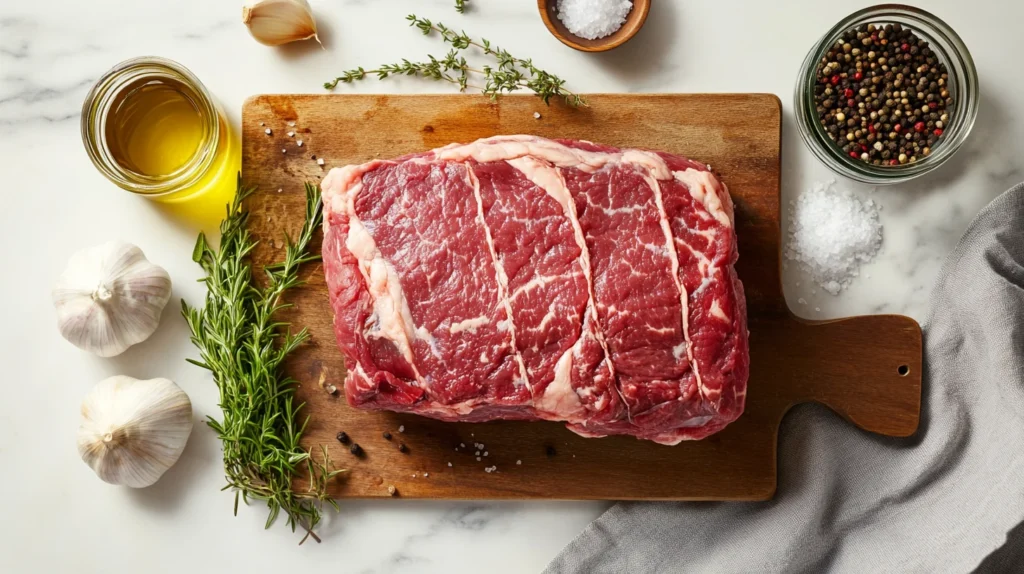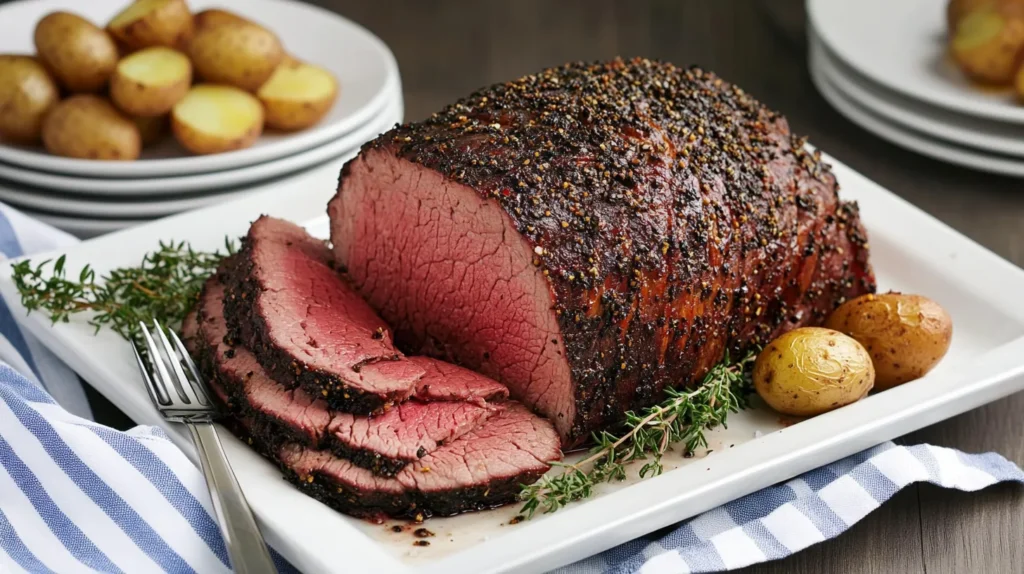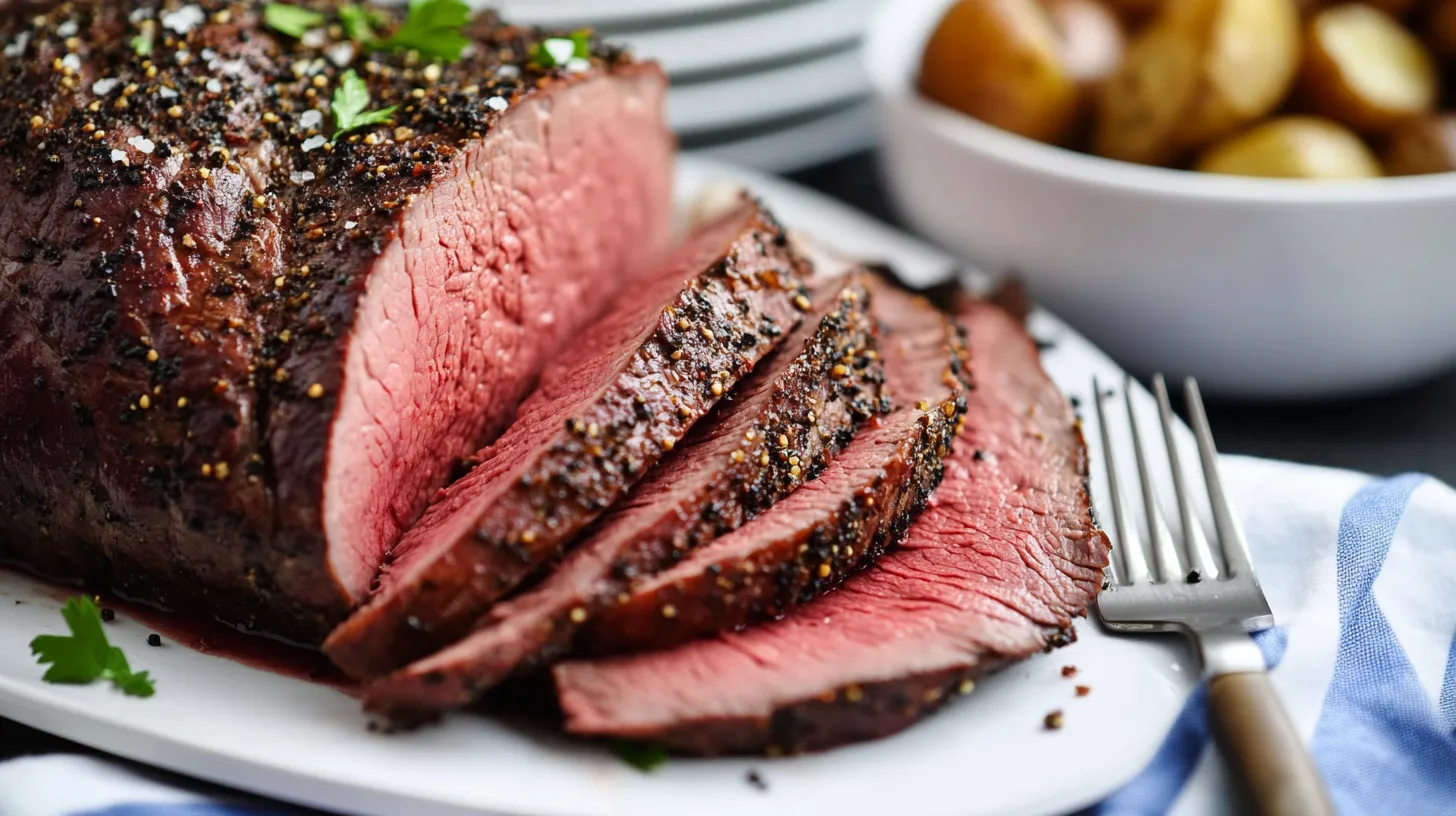You’ve come to the right place if you’re for rump roast recipes in the oven!
The recipe includes easy. Step-by-step instructions to help you make it.
Why Do We Love Rump Roast Recipes in the Oven?
We love rump roast recipes in the oven because they make tender, juicy roast beef with rich flavor. The slow cooking helps break down the meat fibers, making each bite soft and delicious. Simple ingredients like salt, pepper, garlic, and herbs enhance the taste. It’s an easy way to make an excellent dinner for the whole family.
What is Rump Roast Recipes in the Oven?
Rump roast recipes in the oven are cooking methods that turn a lean cut of beef into a flavorful meal. The roast is seasoned, placed in a roasting pan, and baked at a low temp to ensure it stays tender. Some recipes use broth, garlic, rosemary, and thyme for extra flavor. The slow roasting process helps keep the meat juicy and delicious, making it a favorite dish for many.

How to Prepare a Rump Roast for Oven Cooking
Let the rump roast sit at room temperature for 30-60 minutes before cooking. This step helps the meat cook evenly and prevents it from becoming tough.
Trim any excess fat from the roast, leaving a thin layer to keep it moist. Place the roast on a clean surface. Pat it dry with a paper towel to help the seasoning stick.
Rub the roast with salt and pepper for a basic seasoning. Add garlic, rosemary, and thyme for extra flavor. Press the seasoning firmly into the meat to ensure it sticks.
For deeper flavor, use a dry rub or marinade. A dry rub can include paprika, onion powder, and mustard powder. A marinade can combine broth, Worcestershire sauce, and olive oil. Let the roast rest in the refrigerator for several hours or overnight.
Before cooking, remove the roast from the refrigerator and let it sit at room temperature for about 30 minutes. This step ensures even cooking and keeps the meat tender.
Step-by-Step: How to Cook a Rump Roast in the Oven
1. Preheat and Prepare the Roasting Pan
Set the oven temperature between 275°F and 325°F. A lower temperature helps keep the rump roast tender.
Use a roasting pan with a rack. The rack lifts the roast, allowing air to circulate for even cooking.
Pour broth or water into the bottom of the pan. This prevents drying out and adds moisture.
Place the rump roast on the rack. Make sure it is centered for even heat distribution. The roast is now ready for the next step.
2. Searing the Roast (Optional but Recommended)
Searing locks in juices and creates a flavorful crust. Heat oil in a large pot over medium-high heat.
Place the rump roast in the hot oil. Sear each side for 2 minutes. Turn carefully to avoid burning.
After searing all sides, remove the roast from the pot and transfer it to the roasting pan. The golden-brown crust will add rich flavor during baking.
Skipping this step is fine, but searing helps keep the meat juicy and delicious.
3. Seasoning and Cooking
Apply seasoning to the rump roast. Use garlic, rosemary, thyme, salt, and pepper. Press the seasoning into the meat’s surface.
Insert a meat thermometer into the thickest part of the roast. This step ensures accurate Doneness.
Place the roasting pan in the preheated oven. Bake for 20-30 minutes per pound.
Check the broth level occasionally. Add more if needed to prevent drying out. Let the roast cook slowly for the best texture.
4. Checking Doneness with a Meat Thermometer
Use a meat thermometer to check the internal temperature:
- Rare: 120-125°F
- Medium-Rare: 130-135°F
- Medium-Well: 140-145°F (best for a juicy roast)
- Well-Done: 150-155°F (avoid overcooking to prevent dryness)
Remove the rump roast from the oven when it reaches the desired temperature.
Let the roast rest for 15-20 minutes. This step allows the juices to be redistributed, keeping the meat tender.
How to Make Sure Your Rump Roast Stays Juicy and Tender
Cook the rump roast at a low temperature to keep it tender. Set the oven between 275°F and 325°F. Slow cooking allows the meat fibers to break down, making the roast softer and more flavorful.
Let the rump roast rest for 15-20 minutes after cooking. This step helps the juices redistribute, preventing the meat from drying out. Cutting the roast too soon causes the juices to escape, making it less tender.
Slice against the grain to keep the meat soft. Look at the direction of the muscle fibers and cut perpendicular to them. This technique shortens the muscle fibers, making each bite easier to chew.
Use a roasting pan with broth to retain moisture. Add beef broth, water, or red wine to the bottom of the pan. This liquid creates steam, keeping the rump roast from drying out. Baste the roast occasionally with the broth for extra flavor.
To maintain a juicy texture, avoid overcooking. Use a meat thermometer to check the internal temperature. Remove the roast from the oven at 130-135°F for medium-rare or 140-145°F for medium-well. Cooking past 150°F can make the meat dry and tough.

Flavor Variations and Seasoning Ideas
Classic
For a traditional roast flavor, use salt, pepper, garlic, rosemary, and thyme. Rub the rump roast with salt and pepper. Add minced garlic and sprinkle rosemary and thyme evenly. This simple seasoning enhances the natural beef taste while adding an herbal aroma.
Bold and Spicy
Use paprika, cayenne, cumin, and Worcestershire sauce for a bolder flavor. Mix paprika and cayenne for heat, cumin for depth, and Worcestershire sauce for richness. Coat the rump roast evenly, pressing the spices into the meat. This blend gives the roast a smoky, spicy taste.
Herb-Crusted
Use Dijon mustard, breadcrumbs, and Italian herbs for a crusty, flavorful coating. Spread a thin layer of Dijon mustard over the rump roast. Coat it with breadcrumbs, oregano, basil, and parsley. The crust locks in moisture, creating a crispy texture while keeping the inside juicy.
Simple and Easy
For a pure beef flavor, use only salt and pepper. Generously season the rump roast and let it rest before roasting. This easy seasoning allows the rich beef taste to shine.
Side Dishes to Serve with Rump Roast
Roasted Potatoes and Carrots
Toss potatoes and carrots with olive oil, salt, pepper, and garlic. Roast them in the oven alongside the rump roast until golden and tender. The vegetables absorb the roast’s juices, adding extra flavor.
Mashed Potatoes with Gravy
Creamy mashed potatoes pair perfectly with rump roast. For a smooth texture, use butter, milk, and salt. Pour the roast pan drippings over the mashed potatoes for a rich, savory gravy.
Steamed or Roasted Vegetables
Steamed green beans, asparagus, or Brussels sprouts add a fresh contrast to the hearty roast. Roast them with olive oil, garlic, and Parmesan for a richer taste.
Dinner Rolls or Crusty Bread
Serve warm dinner rolls or crusty bread to soak up the juices. The bread enhances the meal, making every bite more satisfying.
Using Leftover Rump Roast
Sandwiches
Slice the leftover rump roast thin and place it on the bread. Add mustard or horseradish for extra flavor. For a classic roast beef sandwich, use a toasted roll with cheese and onions.
Soups & Stews
Cut the leftover roast into chunks and add it to a soup or stew. Use beef broth, vegetables, and seasonings for a hearty meal. The tender meat absorbs the flavors, making the soup rich and satisfying.
Tacos or Burritos
Shred the leftover roast and mix it with taco seasoning. Serve in tortillas with cheese, lettuce, salsa, and sour cream. For a filling dish, use it in burritos with rice and beans.
Slow Cooker Reheating
To keep the leftover roast juicy, reheat it in a slow cooker with broth. Cook on low for 1-2 hours until warm and tender. This method prevents drying out and restores flavor.
Common Mistakes to Avoid When Cooking Rump Roast
Overcooking
Cooking the rump roast too long makes the meat dry and tough. Use a low oven temperature (275°F-325°F) and a meat thermometer to check Doneness. For a juicy roast, remove it at 130-135°F for medium-rare or 140-145°F for medium-well.
Not Using a Meat Thermometer
Guessing the internal temperature can lead to undercooked or overcooked meat. Insert a meat thermometer into the thickest part of the roast. This ensures the correct Doneness and prevents dryness.
Skipping the Resting Period
Let the rump roast rest for 15-20 minutes before slicing. This allows the juices to be redistributed, keeping the meat moist. Cutting too soon releases the juices, making the roast dry.
Slicing the Wrong Way
Always slice against the grain to keep the meat tender. Cutting with the grain results in chewy, tough slices. Look for the muscle fibers and slice perpendicular to them.
Conclusion
Rump roast is a budget-friendly cut that becomes flavorful and juicy when cooked properly. Slow roasting at a low temperature keeps the meat tender. Using the proper seasoning enhances the flavor, so try different herbs and spices to find your favorite way to make it.
Always use a meat thermometer to ensure the correct Doneness and prevent overcooking. Let the roast rest before slicing to keep it juicy.
Serve with delicious side dishes, and enjoy the meal with family. Use leftovers for sandwiches, soups, or tacos for easy meals later!

Slow Rump Roast Recipe
Ingredients
Method
- Preheat oven to 300°F.
- Rub roast with salt, pepper, garlic, rosemary, and thyme.
- Sears are in a hot pan for 2 minutes per side.
- Place in a roasting pan with broth.
- Bake for 20-30 minutes per pound using a meat thermometer.
- Rest for 15-20 minutes, then slice against the grain.
Notes
- Use low heat for a tender roast.
- Let rest before slicing to keep juices inside.
FAQs
How long do I cook a rump roast in the oven?
- Cooking time depends on the oven temperature and roast size. Cook at 275°F – 325°F for 20-30 minutes per pound. Use a meat thermometer to check Doneness.
How do I make a rump roast tender?
- Cook slowly at a low temperature to break down the muscle fibers. Let the rump roast rest for 15-20 minutes after cooking. Always slice against the grain for softer meat.
Should I cover my rump roast while cooking?
- No, cook the rump roast uncovered to allow browning. This creates a flavorful crust while keeping the inside juicy.
Can I use a slow cooker instead?
- A slow cooker is a great way to make rump roast extra tender. Cook on low for 8-10 hours with broth and seasonings.
How do I store leftover rump roast?
- Place leftover roast in an airtight container. Store in the refrigerator for up to 4 days or freeze for 1-2 months. Reheat with broth to keep it moist.





